2002 MERCEDES-BENZ G500 tailgate
[x] Cancel search: tailgatePage 163 of 385
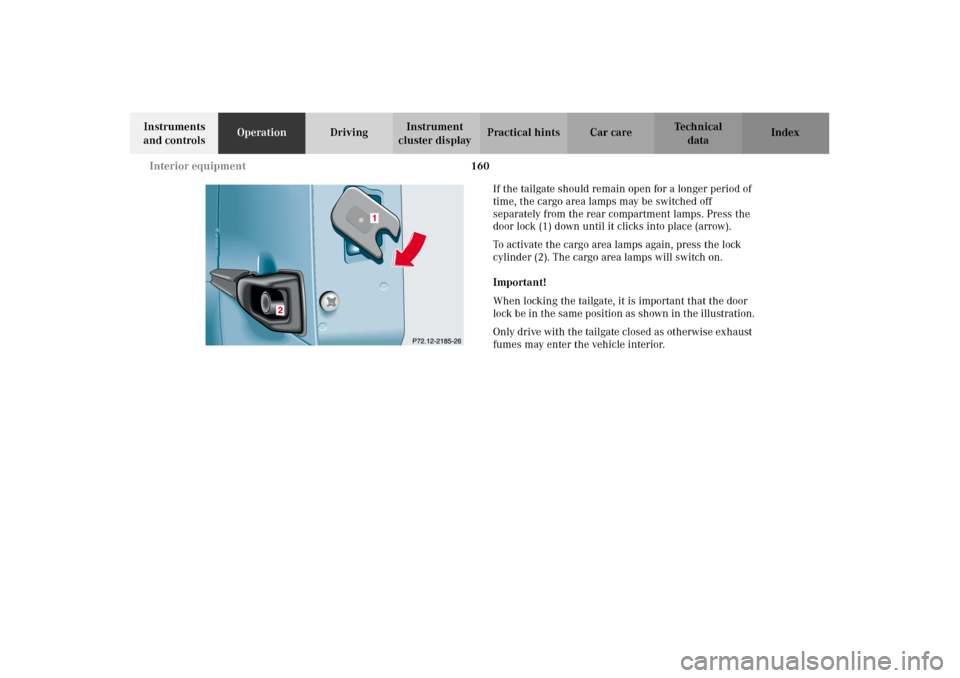
160 Interior equipment
Te ch n i c a l
data Instruments
and controlsOperationDrivingInstrument
cluster displayPractical hints Car care Index
If the tailgate should remain open for a longer period of
time, the cargo area lamps may be switched off
separately from the rear compartment lamps. Press the
door lock (1) down until it clicks into place (arrow).
To activate the cargo area lamps again, press the lock
cylinder (2). The cargo area lamps will switch on.
Important!
When locking the tailgate, it is important that the door
lock be in the same position as shown in the illustration.
Only drive with the tailgate closed as otherwise exhaust
fumes may enter the vehicle interior.
J_G463.book Seite 160 Mittwoch, 19. September 2001 8:06 08
Page 174 of 385
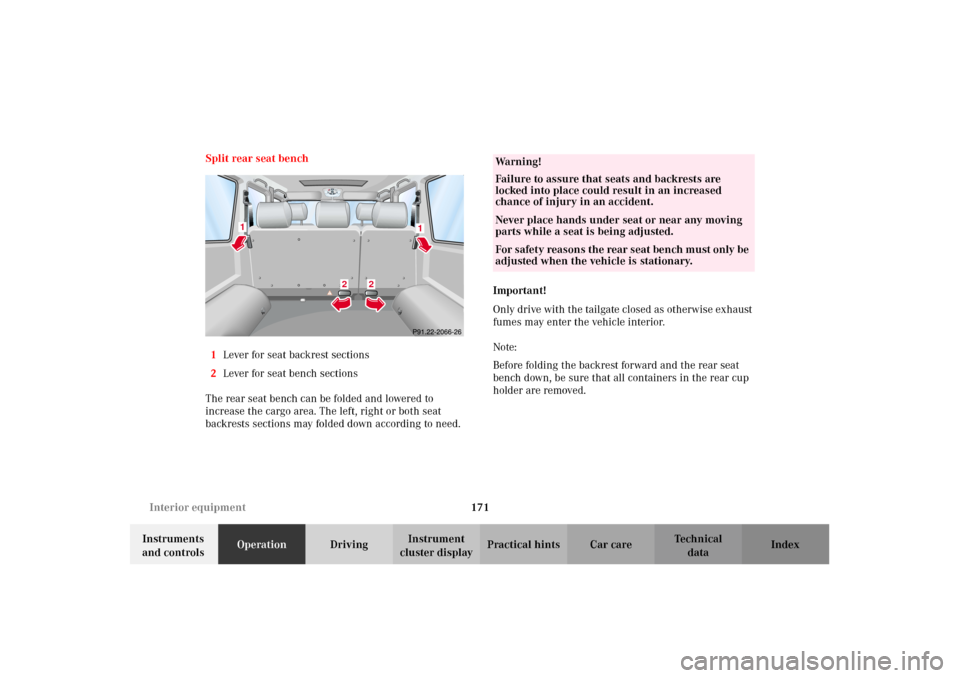
171 Interior equipment
Te ch n i c a l
data Instruments
and controlsOperationDrivingInstrument
cluster displayPractical hints Car care Index Split rear seat bench
1Lever for seat backrest sections
2Lever for seat bench sections
The rear seat bench can be folded and lowered to
increase the cargo area. The left, right or both seat
backrests sections may folded down according to need.Important!
Only drive with the tailgate closed as otherwise exhaust
fumes may enter the vehicle interior.
Note:
Before folding the backrest forward and the rear seat
bench down, be sure that all containers in the rear cup
holder are removed.
1
2
2
1
Wa r n i n g !
Failure to assure that seats and backrests are
locked into place could result in an increased
chance of injury in an accident.Never place hands under seat or near any moving
parts while a seat is being adjusted.For safety reasons the rear seat bench must only be
adjusted when the vehicle is stationary.
J_G463.book Seite 171 Mittwoch, 19. September 2001 8:06 08
Page 182 of 385
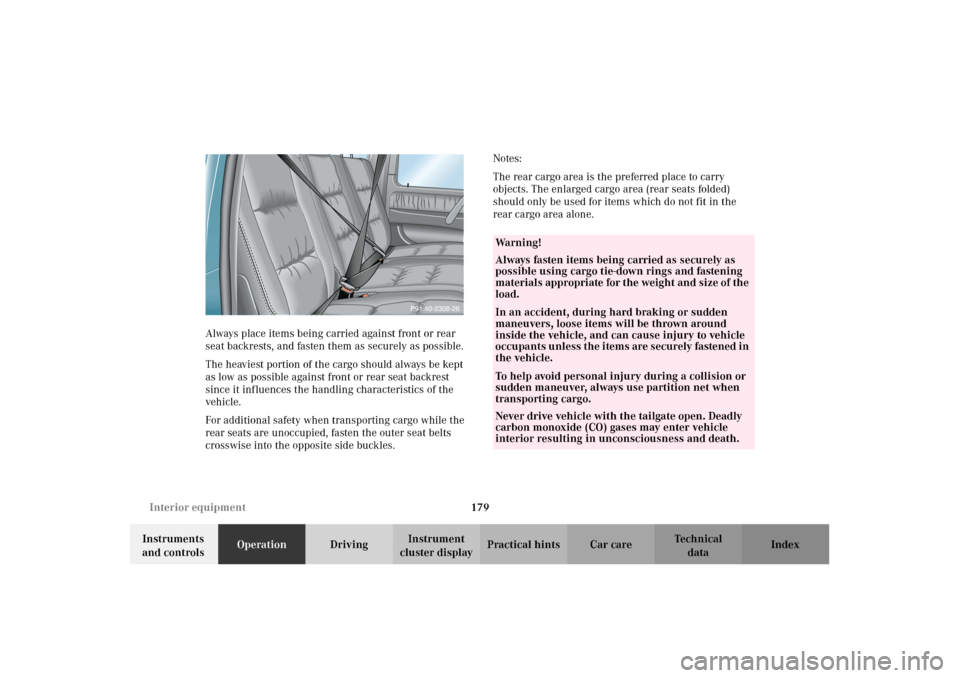
179 Interior equipment
Te ch n i c a l
data Instruments
and controlsOperationDrivingInstrument
cluster displayPractical hints Car care Index Always place items being carried against front or rear
seat backrests, and fasten them as securely as possible.
The heaviest portion of the cargo should always be kept
as low as possible against front or rear seat backrest
since it influences the handling characteristics of the
vehicle.
For additional safety when transporting cargo while the
rear seats are unoccupied, fasten the outer seat belts
crosswise into the opposite side buckles.Notes:
The rear cargo area is the preferred place to carry
objects. The enlarged cargo area (rear seats folded)
should only be used for items which do not fit in the
rear cargo area alone.
Wa r n i n g !
Always fasten items being carried as securely as
possible using cargo tie-down rings and fastening
materials appropriate for the weight and size of the
load.In an accident, during hard braking or sudden
maneuvers, loose items will be thrown around
inside the vehicle, and can cause injury to vehicle
oc cu pa nt s u nl ess t he i tem s are s ecurely fastened i n
the vehicle.To help avoid personal injury during a collision or
sudden maneuver, always use partition net when
transporting cargo.
Never drive vehicle with the tailgate open. Deadly
carbon monoxide (CO) gases may enter vehicle
interior resulting in unconsciousness and death.
J_G463.book Seite 179 Mittwoch, 19. September 2001 8:06 08
Page 183 of 385
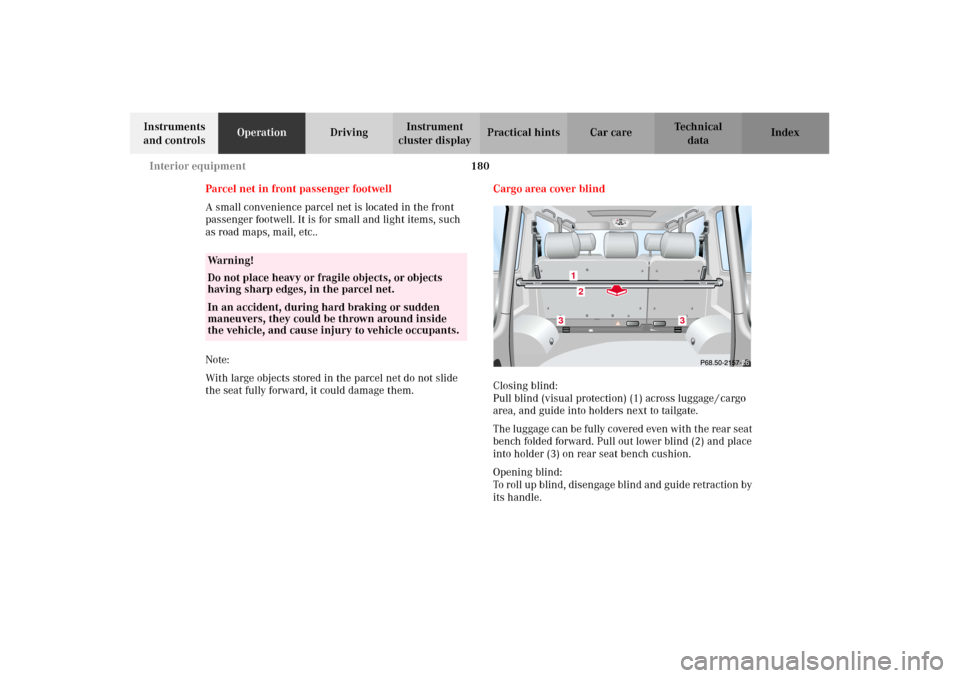
180 Interior equipment
Te ch n i c a l
data Instruments
and controlsOperationDrivingInstrument
cluster displayPractical hints Car care Index
Parcel net in front passenger footwell
A small convenience parcel net is located in the front
passenger footwell. It is for small and light items, such
as road maps, mail, etc..
Note:
With large objects stored in the parcel net do not slide
the seat fully forward, it could damage them.Cargo area cover blind
Closing blind:
Pull blind (visual protection) (1) across luggage / cargo
area, and guide into holders next to tailgate.
The luggage can be fully covered even with the rear seat
bench folded forward. Pull out lower blind (2) and place
into holder (3) on rear seat bench cushion.
Opening blind:
To roll up blind, disengage blind and guide retraction by
its handle.
Wa r n i n g !
Do not place heavy or fragile objects, or objects
having sharp edges, in the parcel net.In an accident, during hard braking or sudden
maneuvers, they could be thrown around inside
the vehicle, and cause injury to vehicle occupants.
21
3
3
J_G463.book Seite 180 Mittwoch, 19. September 2001 8:06 08
Page 203 of 385
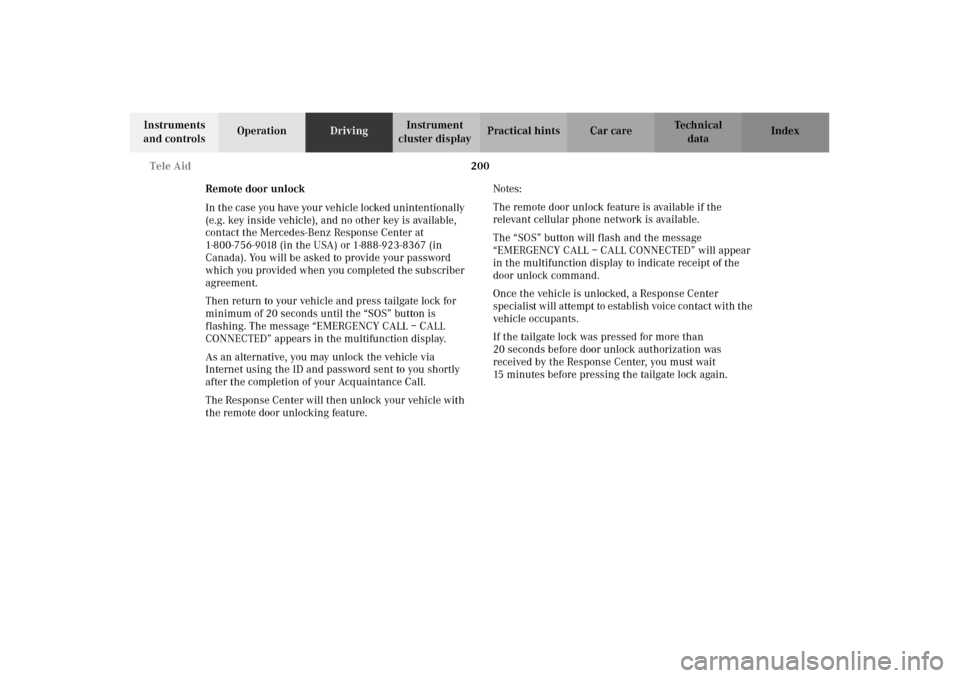
200 Tele Aid
Te ch n i c a l
data Instruments
and controlsOperationDrivingInstrument
cluster displayPractical hints Car care Index
Remote door unlock
In the case you have your vehicle locked unintentionally
(e.g. key inside vehicle), and no other key is available,
contact the Mercedes-Benz Response Center at
1-800-756-9018 (in the USA) or 1-888-923-8367 (in
Canada). You will be asked to provide your password
which you provided when you completed the subscriber
agreement.
Then return to your vehicle and press tailgate lock for
minimum of 20 seconds until the “SOS” button is
flashing. The message “EMERGENCY CALL – CALL
CONNECTED” appears in the multifunction display.
As an alternative, you may unlock the vehicle via
Internet using the ID and password sent to you shortly
after the completion of your Acquaintance Call.
The Response Center will then unlock your vehicle with
the remote door unlocking feature.Notes:
The remote door unlock feature is available if the
relevant cellular phone network is available.
The “SOS” button will flash and the message
“EMERGENCY CALL – CALL CONNECTED” will appear
in the multifunction display to indicate receipt of the
door unlock command.
Once the vehicle is unlocked, a Response Center
spe cialist will attempt to establis h voic e con tact wit h t he
vehicle occupants.
If the tailgate lock was pressed for more than
20 seconds before door unlock authorization was
received by the Response Center, you must wait
15 minutes before pressing the tailgate lock again.
J_G463.book Seite 200 Mittwoch, 19. September 2001 8:06 08
Page 229 of 385
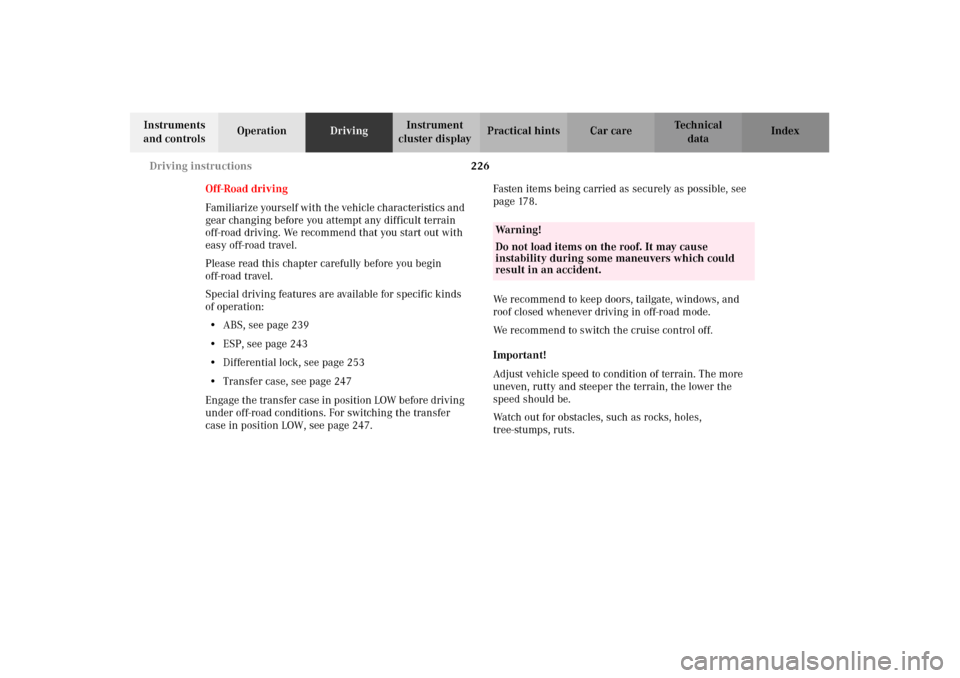
226 Driving instructions
Te ch n i c a l
data Instruments
and controlsOperationDrivingInstrument
cluster displayPractical hints Car care Index
Off-Road driving
Familiarize yourself with the vehicle characteristics and
gear changing before you attempt any difficult terrain
off-road driving. We recommend that you start out with
easy off-road travel.
Please read this chapter carefully before you begin
off-road travel.
Special driving features are available for specific kinds
of operation:
•ABS, see page 239
•ESP, see page 243
•Differential lock, see page 253
•Transfer case, see page 247
Engage the transfer case in position LOW before driving
under off-road conditions. For switching the transfer
case in position LOW, see page 247.Fasten items being carried as securely as possible, see
page 178.
We recommend to keep doors, tailgate, windows, and
roof closed whenever driving in off-road mode.
We recommend to switch the cruise control off.
Important!
Adjust vehicle speed to condition of terrain. The more
uneven, rutty and steeper the terrain, the lower the
speed should be.
Watch out for obstacles, such as rocks, holes,
tree-stumps, ruts.
Wa r n i n g !
Do not load items on the roof. It may cause
instability during some maneuvers which could
result in an accident.
J_G463.book Seite 226 Mittwoch, 19. September 2001 8:06 08
Page 289 of 385
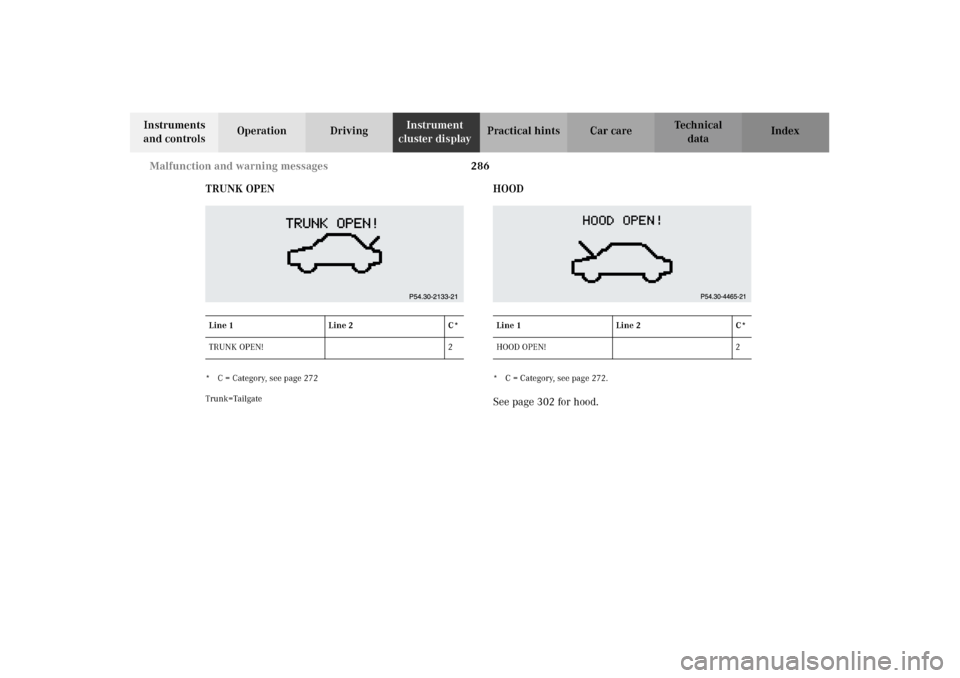
286 Malfunction and warning messages
Te ch n i c a l
data Instruments
and controlsOperation DrivingInstrument
cluster displayPractical hints Car care Index
TRUNK OPEN
* C = Category, see page 272
Trunk=Tailgate
HOOD* C = Category, see page 272.See page 302 for hood.
Line 1 Line 2 C*
TRUNK OPEN! 2
Line 1 Line 2 C*
HOOD OPEN! 2
J_G463.book Seite 286 Mittwoch, 19. September 2001 8:06 08
Page 373 of 385
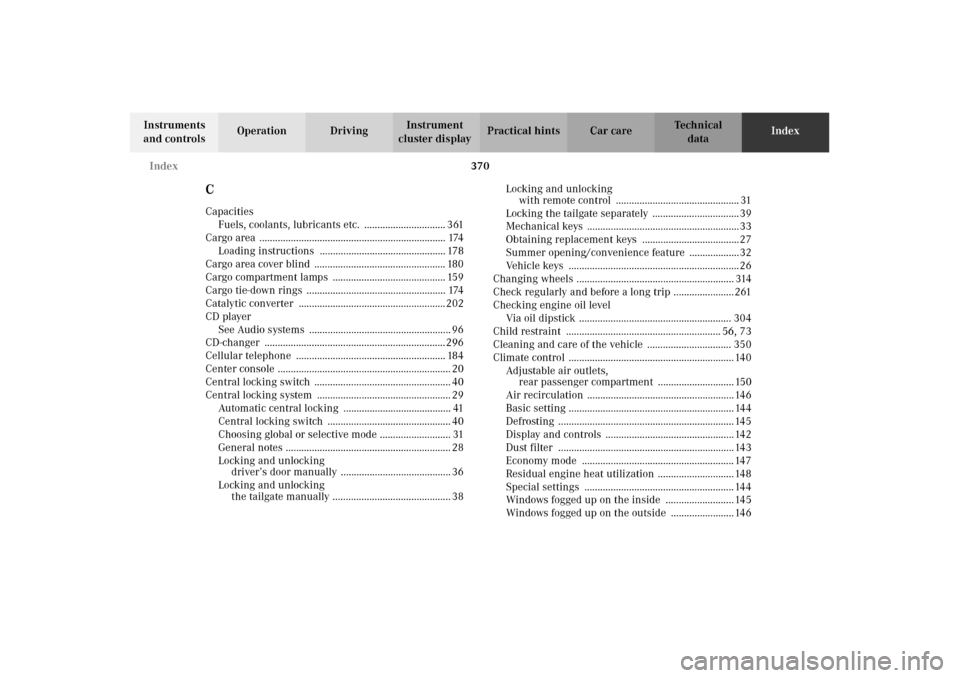
370 Index
Te ch n i c a l
data Instruments
and controlsOperation DrivingInstrument
cluster displayPractical hints Car careIndex
CCapacities
Fuels, coolants, lubricants etc. ............................... 361
Cargo area ....................................................................... 174
Loading instructions ................................................ 178
Cargo area cover blind .................................................. 180
Cargo compartment lamps ........................................... 159
Cargo tie-down rings ..................................................... 174
Catalytic converter ........................................................ 202
CD player
See Audio systems ...................................................... 96
CD-changer ..................................................................... 296
Cellular telephone ......................................................... 184
Center console .................................................................. 20
Central locking switch .................................................... 40
Central locking system ................................................... 29
Automatic central locking ......................................... 41
Central locking switch ............................................... 40
Choosing global or selective mode ........................... 31
General notes ............................................................... 28
Locking and unlocking
driver’s door manually .......................................... 36
Locking and unlocking
the tailgate manually ............................................. 38Locking and unlocking
with remote control ............................................... 31
Locking the tailgate separately ................................. 39
Mechanical keys ..........................................................33
Obtaining replacement keys .....................................27
Summer opening/convenience feature ...................32
Vehicle keys ................................................................. 26
Changing wheels ............................................................ 314
Check regularly and before a long trip ....................... 261
Checking engine oil level
Via oil dipstick .......................................................... 304
Child restraint ........................................................... 56, 73
Cleaning and care of the vehicle ................................ 350
Climate control ............................................................... 140
Adjustable air outlets,
rear passenger compartment ............................. 150
Air recirculation ........................................................ 146
Basic setting ............................................................... 144
Defrosting ................................................................... 145
Display and controls ................................................. 142
Dust filter ................................................................... 143
Economy mode .......................................................... 147
Residual engine heat utilization ............................. 148
Special settings ......................................................... 144
Windows fogged up on the inside .......................... 145
Windows fogged up on the outside ........................ 146
J_G463.book Seite 370 Mittwoch, 19. September 2001 8:06 08